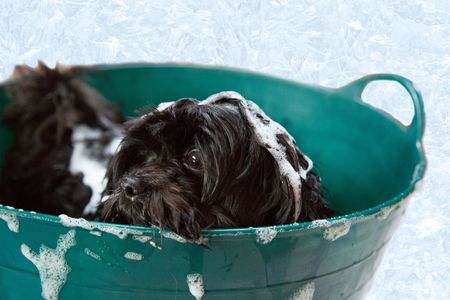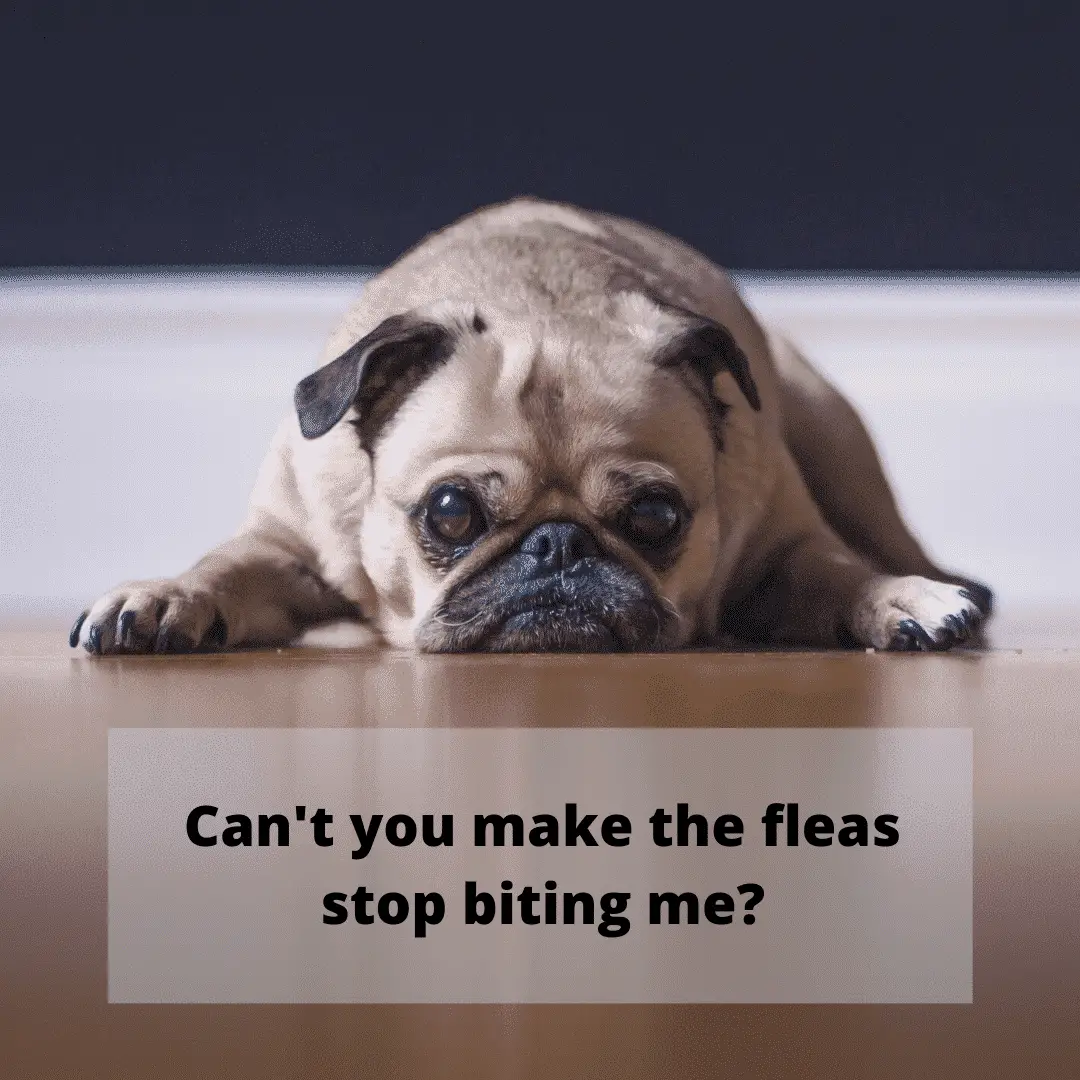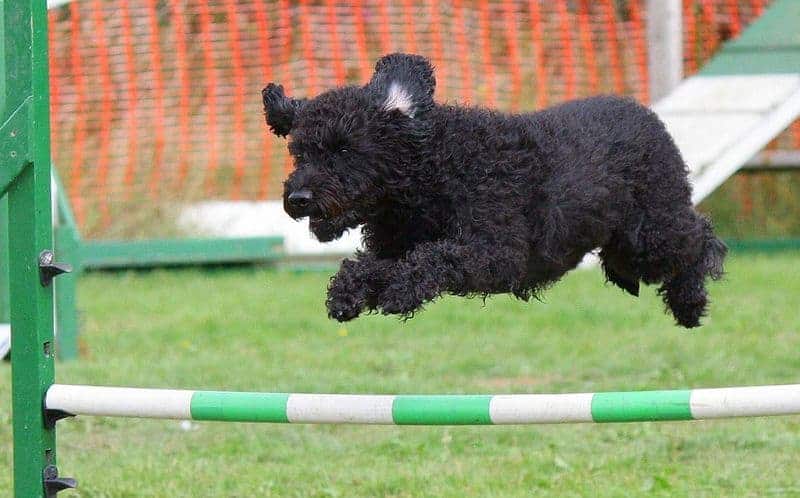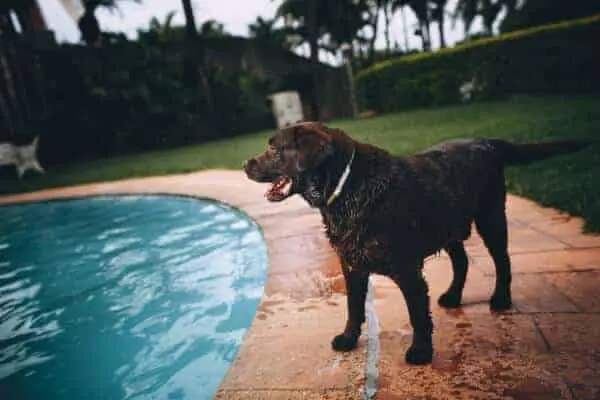Fleas, they’ve been around for 40-50 million years and are unlikely to be gone any time soon. This means that we will be dealing with them upsetting our dogs for the foreseeable future.
In this guide we’re going to look at what fleas are, how to de-flea your dog and also how to de-flea your home. While we commonly think about how we would de-flea our dogs we regularly forget that once fleas come into our homes they will make themselves at home and infesting your dog again, even after we have just de-flead them. As with a lot of things, it is worth getting your vet’s view on the best approach for your dog.

What are fleas
If you’re a dog owner and not already very familiar with fleas then you can count yourself very lucky. Flea infestations are one of the biggest problems that dog owners face when caring for our dogs.
Fleas are tiny, about 1-2 millimeters in size, parasites that like to live in animals fur and drink their blood. They can live between one and two weeks and during that time will bite your dog numerous times, which will cause irritation to your dogs skin. This can result in a lot of scratching, which can end up damaging your dogs skin and increasing the likelihood that the fleas will go for the same area as it will be easier to get to the blood.
Fleas are known for being able to reproduce very quickly and go from one or two fleas to a full blown infestation in next to no time. This is because female fleas can lay up to 40 half-millimeter white oval shaped eggs a day! They hatch from their eggs becoming larvae at which point they will nest down in any soft area they can where they will develop.
One of the things that makes it harder to eradicate fleas is that the eggs and larvae don’t necessarily end up living on your dog. When the eggs are laid they initially start off with a sticky outer layer, which is eventually lost, resulting the in eggs dropping off wherever your dog happens to be at the time. Some of the favorite places for fleas to develop into adults are places like your dog’s bedding, carpets/rugs and any other soft furnishings in your home.
Late summer is prime time for fleas as they like warm humid weather. But don’t think that fleas are nice enough to give you the winter off. As most dogs will live indoors with us and, importantly, our central heating, this means that fleas can still take hold during winter as well.
How to tell if your dog has fleas
Scratching and over-grooming as key signs. If left long enough this can start to materialize as bald patches on their coat as they scratch aware the fur where they’ve been bitten.
Even if you regularly groom your dog you won’t stop your dog from getting fleas but you’re more likely to notice them earlier, which will make dealing with the fleas far easier. This is just another good reason to groom your dog regularly on top of improving the bond between you.
How do dogs get fleas
You can go out of your way to ensure that your little furry friend is kept away from sources of fleas and other pests but they still some how manage to get them. Fleas are incredibly difficult to prevent and can come for a variety of places. Below are a few common ones.
Animals
The most common cause of your dog getting fleas is through exposure to other animals that are carrying fleas. These could be other pets, birds and rodents. Your dog doesn’t need to have got very close, fleas are known for their ability to jump and your dog can pick them up from infested areas where those animals have been.
One unfortunate thing for dogs is that while the dog flea (Ctenocephalides canis) will only really go for dogs, the cat equivalent is not so picky and is more than happy to get comfortable on your dog.
Infested soft furnishings
Fleas are very adept at hitchhiking to get to new places to eat and due to how many of them a single animal can carry they can be shed everywhere. Examples of where you might end up accidentally bring fleas into your home are second hand items, such as dog bedding, plush toys and blankets. If you buy things like these second hand then make sure to properly clean them prior to getting them near your home, to avoid even bringing them into the home.
Shared dog facilities
Do you take your dog to doggie daycare? How about a local groomer? Due to the large number of dogs coming through these sorts of places it can be hard for them to prevent fleas coming in. That’s not to say that organisations don’t try to prevent it, it is in their best interest to avoid their premises becoming infested as dog owners would quickly stop coming to their business.
Methods to de-flea your dog
If you notice fleas on your dog then it is worth starting treatment as soon as possible. Fleas are not a problem that will go away if ignored.
You should only use flea treatments suitable for dogs on your dog and the same goes for other pets. An example of why this is important is that some flea treatments for dogs contain chemicals that, while safe for dogs, are toxic to cats.
Flea bath / flea shampoo
Flea baths, or using flea shampoo can be a great way to get rid of fleas if your dog is currently infested rather than being used as a preventative measure. A flea bath is exactly what it sounds like, where you give your dog a bath and use a special flea shampoo to kill off any fleas that your dog may have on it. It is an easy way to cover off the whole of your dog’s body in one go.

While you may be tempted to use hot water to try and help kill off the fleas, this isn’t a good idea as dogs overheat far easier than humans.
Start with the neck and work your way down the body. This prevents fleas from fleeing towards your dogs face where it is much harder for you to shampoo properly. As the shampoo has some nasty chemicals in it you should look to avoid the shampoo going into your dogs ears, eyes or mouth.
Make sure to properly rinse off your dog after the flea bath. This prevents the chemicals from being left on your dog’s skin an irritating them. It may also be worth using a conditioner afterwards to help moisturize their skin.
It is worth trying to find a flea shampoo that will kill of both fleas and their eggs, this helps to prevent a reoccurrence.
Flea collars
Flea collars are pretty much exactly what they sound like, collars for your dog that have chemicals in them to help kill off fleas.
A lot of older flea collars were overly harsh and could result in skin irritation and even hair loss for your dog but most modern flea collars are kinder to your dogs skin. Despite this, if you decide to get a flea collar for your dog it is worth keeping an eye on the skin around the collar to make sure your dog doesn’t have a bad reaction.
Pest collars are much better suited for preventing ticks than fleas. Ticks tend to prefer the neck and face of dogs, which is the area that is most effectively covered by collars due to their proximity. Fleas however are happy to go anywhere on your dog, and the effectiveness of the collar decreases the further from the collar you area.
If you infrequently use a collar, there are some suggestions that you can put it in an airtight bag to keep it for longer. Flea collars can last up to 8 months, though check the instructions on the particular brand you buy to ensure you get the right amount of time.
Important: If you have children then you will want to be careful with flea collars, the active ingredients in flea collars can be harmful to children, who may grab hold of the collar and then put their fingers in their mouths.
Flea combs
Flea combs are a as you might expect, combs that are designed to remove fleas from your dog’s fur. They do this by having tiny gaps between the teeth of the comb, which are too small for fleas to fit through. Flea combs are a good choice for the occasional use to check if there are any fleas but if your dog is infested then it is far easier to use something such as spot-on treatments or flea baths.
As the gaps between the teeth on flea combs are so small you should look to brush your dogs coat through thoroughly before using a flea comb. This is to ensure there aren’t any knots, this will help make your life easier when you’re using the flea comb on them.
You should look to comb them from the top to the bottom, starting from their ears and working your way back towards their tail. You should look to pay close attention to the neck, ears and around where your dogs legs meet the body as these are hot-spots for fleas.
If you’re combed inside of your house then make sure that you vacuum in that area to capture any little escapees.
Electric flea combs
In addition to normal flea combs you can buy electric flea combs. These are similar to normal flea combs but the teeth are electrified. The purpose of this is to shock any fleas that come into contact with the teeth to prevent them jumping away to other areas of your dog or your house.
Flea powder
This is one of the most traditional ways to treat your dog for fleas. You start by sprinkling the flea powder all over your dogs coat but can also be used on their bedding or carpets where you think fleas may be living. The flea powder is designed to kill fleas on contact.
Flea powder is only effective while it is in your dog’s coat. If you bath them or they get wet then this will wash the flea powder off.
One word of warning with flea powders, they use chemicals to kill off the fleas (as do all the other methods) and by putting it on your dog’s fur it can lead to illness if the powder is swallowed or inhaled by your dog. Not an ideal situation. It is also probably not a good solution for new puppies as they are more likely to have a reaction to the chemicals.
Spot-on remedies
Probably the most common placed approach for killing off fleas these days. By applying spot on treatments your dogs neck and back, the chemicals are absorbed into your dogs blood. This approach is very effective as fleas and ticks want to drink your dogs blood, doing so they drink the chemicals which are designed not to hurt your dog but to kill off the fleas.
While all spot-on remedies are designed to kill off the fleas, some are even designed to prevent flea eggs from hatching, which helps prevent a re-emergence.
The larger your dog the more drops of spot-on remedies you’ll need to apply. Make sure to read the instructions on whatever brand of treatment you end up going for as this will give you details on how many drops are suitable for your dog.
How to de-flea your home
One thing that is commonly forgotten when people think about fleas is that it is not just your dog that you have to de-flea it is your home as well.
As fleas will grow in any soft furnishings that they can get comfortable in, you need to ensure that you get rid of as many of them from your home as you can.
You will need to wash every bit of fabric in your home and vacuum everything multiple times to try and pick up all the fleas.
Flea carpet powder
As you’re probably noticing by this point in the guide, most of these products do exactly what their name suggests and flea carpet powder is no different. Carpet powder is a powder that you dust over your carpet and soft furnishings to kill off fleas.
Each carpet powder is slightly different so read the instructions to see how long you need to leave the powder there for. This will tend to need 8+ hours.
When you’ve left the powder on the carpet for long enough you will need to vacuum it up. This is to both vacuum up the powder but also any dead fleas and eggs (make sure to dispose of the vacuum bag soon to avoid any eggs that didn’t get killed off hatching and reinfesting your home). It is worth doing a couple passes with the vacuum to make sure you pick up all of the powder.
Make sure that you get up to the corners of the room as this is a favorite spot for fleas and can be easily missed with a powder.
Important: If you had children, especially small ones remember that they are likely to crawl around on the carpet. If you’re treating a room it is worth keeping your children out of the room until you have properly vacuumed up all the powder.
Flea fogger
Flea foggers, also known as flea bombs, are small aerosol canisters that are full of insecticides. When you set off a flea fogger, it will start spraying the insecticide directly up. It is therefore very important that you’re careful when you’re setting them off to avoid getting sprayed with the chemicals.
As flea foggers spray up, it means that they will struggle to get places like under sofas and similar areas. While flea bombs will cover a large area (an entire room) in one go you are likely to need to use multiple of them to get as close to 100% eradication as you can. If you’re able to move furniture around between foggings it can help to increase your coverage.
All electrical devices should be turned off when you’re fogging your home, this goes doubly for any ignition systems. The chemicals in foggers can be highly flammable. Yes, blowing your house up would likely get rid of the fleas, it’s a little overkill for what we are trying to do. Probably the easiest way to do this is to turn off the power at the distribution board.
Important: As flea foggers use insecticides you should ensure that you keep your family and pets away when you’re using them to avoid them breathing in the chemicals. You should also take appropriate measures to protect yourself.
You should look to leave flea foggers fog several hours after you’ve set them off (check the instructions for your particular product, some require to be left for days). After that time you will need to open up the house as much as possible to allow the it to ventilate. As your house will then be covered in a layer of insecticide you will need to give it a good clean and vacuum. You will also need to wash items that would have been exposed to the poisonous fog.
One approach to doing this is to set the foggers off before you head off on holiday, this will allow the fogger plenty of time to do its thing while you’re away but it does mean you’ll have to give the whole house a good clean when you get back from holiday, something you may not feel up to.
Flea spray for furniture
Killing fleas from your furniture can be troublesome. This is because there tend to be lots of small areas that fleas can hide. This is where flea sprays come in useful, they can be used for quickly and easily getting areas where fleas are hiding that may be more awkward to get to using other means.

A flea spray is a more directed and controlled version of the flea fogger/bomb. It allows you to only target the areas you want and can allow you to get places a flea bomb wouldn’t, by doing things like lifting up sofa cushions or pointing the spray under the sofa.
Flea sprays are also great for getting into areas that would be harder to reach with other methods such as around the corners of your room.
It is worth looking for flea sprays that not only kill off fleas but make any fleas or eggs that manage to survive the spray infertile and unable to reproduce.
Flea spray for yard
As your yard is likely to be a space that your dog will spend a decent amount of time, if there are fleas residing in your yard then they will likely pick them up from there.
Similar to flea sprays for your home, you will be spraying insecticide around your yard to kill off fleas and other nasties that will enjoy nibbling on your dog.
It is also worth thinking about clearly out your yard as much as possible. By decreasing the number of places that fleas could be hiding out it makes it more likely that you’ll be able to kill them off when you spray your yard or use any other mechanism for killing fleas in your yard.
One thing it is worth keeping in mind when you’re spraying your yard with insecticide is not all insects are bad, so use it considerately. For example there’s a lot of concern at the moment on the impact of insecticides on bees and other pollinating insects, which are necessary for keeping a lot of plant life reproducing. If you’re facing a current infestation then using a flea spray may be the best course of actions but it shouldn’t be used as a regular preventative activity. One of the two next items would be a far better solution for longer term maintenance.
Introduce nematodes to your yard
Nematodes are a type of microscopic worm who’s favorite food is fleas and ticks. This can mean that they can be a great approach for killing off fleas in your yard. There is also the added benefit that nematodes are a pretty cheap control that you can use.
Use cedar wood chips
Another natural approach that you can use for keeping fleas out of your yard is by using cedar wood chips or oils. This can help new fleas coming into your yard as they are repelled by the cedar.
Wrapping up
We hope this guide has given you plenty of ideas for how you can both deal with current flea infestations and also put in place preventative measures to try and reduce the chances that your furry little friend will have flea problems (though they’re bound to still have them from time to time).
We would be interested to hear whether there are other methods that you’ve tried for getting rid of fleas and how effective you have found them in the comments below.








